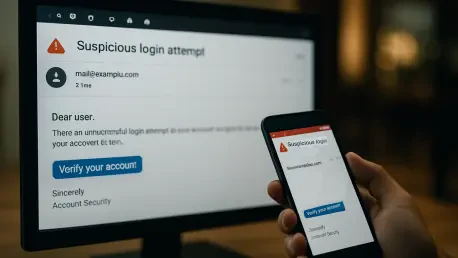What happens when the smartphone in your hand, a device trusted for everything from banking to personal chats, turns into a gateway for cybercriminals? In 2025, mobile phishing attacks have surged, exploiting the very tools we rely on daily, and with attackers shifting their focus from email to mobile channels, the question looms: are current security measures keeping up with this stealthy, personal threat? This alarming trend sets the stage for a deeper look into how mobile devices have become the new frontier of cybercrime.
Why Mobile Phishing Dominates Cybercrime Today
Mobile devices are no longer just gadgets; they are extensions of personal and professional lives. Cybercriminals have taken notice, pivoting to mobile phishing as a primary attack vector. Unlike traditional email scams, these threats arrive through SMS, voice calls, and even QR codes, striking directly at users when they least expect it. The intimacy and immediacy of mobile communication make these attacks particularly dangerous, as they often bypass the skepticism users apply to other platforms.
The stakes are higher than ever. A single tap on a malicious link can compromise sensitive data, from bank credentials to corporate access codes. With billions of smartphones in use globally, the potential for widespread damage is immense. This shift represents not just a change in tactics but a fundamental challenge to how security is approached in a mobile-first world.
The Move from Email to Mobile: A Dangerous Oversight
For decades, email stood as the main battlefield for phishing attempts, with spam filters and user training forming the first line of defense. However, the landscape has transformed dramatically, with mobile channels now taking center stage. Attackers exploit SMS, instant messaging apps, and direct calls, capitalizing on the trust users place in personal devices and their often distracted state while on the go.
This transition reveals a critical blind spot in security frameworks. Many enterprises still pour resources into email protection while neglecting mobile-specific threats. The result is a growing vulnerability, as users face attacks that traditional tools are ill-equipped to detect. For individuals and organizations alike, the implications are stark: ignoring mobile risks could lead to devastating breaches.
Unpacking the Tactics of Mobile Phishing Attacks
Mobile phishing is not a singular threat but a complex web of strategies designed to deceive. SMS phishing, or smishing, often masquerades as urgent alerts from banks or delivery services, prompting users to click malicious links. Voice phishing, known as vishing, uses spoofed calls to impersonate trusted entities, tricking victims into sharing sensitive information over the phone. QR code phishing, or quishing, hides malware in seemingly harmless scans, turning everyday actions into traps.
Data paints a grim picture of the impact. A staggering 41% of phishing incidents now involve mobile methods, according to TechMagic, showcasing how these tactics evade conventional defenses. Real-world cases, like a 2025 incident where a major retailer’s customers were targeted with fake delivery QR codes, highlight the scale of disruption. These attacks succeed by exploiting human trust, making them uniquely effective on mobile platforms.
Expert Warnings on the Mobile Security Shortfall
Industry leaders have sounded the alarm on the gap between current security investments and the reality of mobile threats. Jim Dolce, CEO of Lookout, notes that while the email security market is projected to grow from $5.17 billion in 2025 to $10.68 billion by 2032, mobile protection remains critically underfunded. This imbalance leaves enterprises exposed to attacks that target human behavior rather than just systems.
Experts argue that the focus on email has created a false sense of security. Mobile attacks often bypass technical safeguards by directly manipulating users through social engineering. This human-centric approach by cybercriminals demands a rethink of defense strategies, as traditional tools fail to address threats outside their scope. The consensus is clear: without adaptation, the security lag will only widen.
Strategies to Counter Mobile Phishing Risks
Combating mobile phishing requires a proactive, layered approach tailored to the unique nature of these threats. For individuals, simple habits can make a difference—verifying unexpected QR codes before scanning, questioning unsolicited calls, and enabling multi-factor authentication on mobile accounts. These steps reduce the likelihood of falling prey to deceptive tactics.
Enterprises, on the other hand, must invest in advanced solutions. AI-driven tools that analyze message content and intent in real time offer a promising way to detect suspicious activity before it reaches users. Additionally, regular training programs can equip employees to recognize and report mobile threats, strengthening the human layer of defense. By combining technology with awareness, a more resilient posture against mobile phishing can be achieved.
Reflecting on the Path Forward
Looking back, the rapid rise of mobile phishing caught many off guard, exposing vulnerabilities in a world increasingly tied to smartphones. The shift from email to mobile channels revealed how deeply human behavior influences security outcomes, often outpacing the tools designed to protect. Each tactic, from smishing to quishing, underscored the need for vigilance beyond traditional measures.
Yet, the lessons learned pointed toward actionable change. Adopting AI-driven defenses and prioritizing user education emerged as critical steps to close the gap. Moving forward, a commitment to balancing technological innovation with human-focused strategies offers the best chance to stay ahead of evolving threats, ensuring that mobile devices remain tools of empowerment rather than exploitation.









